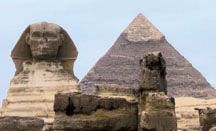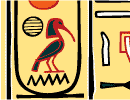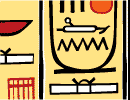by Siona
Jenkins
Imagine for a moment that you are responsible for the last remaining
wonder of the ancient world, charged with protecting it from frenzied
urban growth and an endless stream of tourists. Imagine that you also have
under your care three other fields of pyramids, Egypt's first metropolis,
and a desert oasis potentially filled with Greco-Roman treasures.
Everyone from archaeologists to New Age gurus demands the right to dig
among these splendid monuments, and nature itself is beating them down.
Your country desperately needs the money spent by mesmerized tourists, but
eternal condemnation is the price of failing in your task.
That is the burden borne every day by Zahi Hawass, the keeper of the
pyramids.
|

Huyge |
|
Hawass is a top bureaucrat, a former Fulbright Fellow, a tour guide for
the world's VIPs, and a television personality with one of the best-known
faces in archaeology. But always and above all, Hawass is an
archaeologist: "In my job, you have to wear lots of hats. But the hat for
taking VIPs [on private tours] is very temporary. The hat for attending
meetings is useless. I do mainly the archaeology: the excavations and the
publications. This is what I really care about."
Usually seen sporting a wide-brimmed felt hat and jeans, the outspoken
Hawass has little time for false modesty. "Compare what I do with an
American archaeologist who comes and excavates full time and then returns
to the U.S. and teaches one or two courses," he says in his fluent but
distinctive English. "I am full of 100 percent responsibilities every day
and have still produced more than 85 articles over the past year."
Hawass has produced a prodigious number of academic publications, along
with lecture tours and film collaborations. An inveterate charmer and
adept media personality, he is a regular on Egyptian, European, and
American television.
Yet Hawass came to archaeology almost by default. The son of a
prosperous farmer from a village in northern Egypt, Hawass left home at
age 16 to study law at the University of Alexandria. It didn't take long
for him to realize that he was not cut out to be a lawyer. While casting
about for a new major, Hawass was told that a new department, Archaeology,
had just opened and was looking for students.
Ironically, given that incredibly high-profile archaeology had been
practiced in Egypt - but by Europeans and Americans - for more than a
century, the young student had never heard of the discipline. He signed
up, nonetheless, and he was quickly disappointed in his choice.
The supposedly exciting new discipline seemed to consist of little more
than administrative work at Egypt's many archaeological sites. The only
time he recalls seeing a dig was when a professor showed the class how to
make a grid of an excavation.
"When I graduated, I still did not like it, and I said to myself, 'No
way; I'm not going to work in this job,'" he recalls. But in 1969, after
trying - and failing - to get into the diplomatic corps, he swallowed his
pride and became an inspector for the Egyptian Antiquities Organization.
He worked on several digs in Middle and Upper Egypt, including in 1969 a
joint University of Pennsylvania-Yale expedition at Abydos, which began
what was to become a lasting connection with the University of
Pennsylvania. But still, he did not feel "involved in real archaeology."
That changed in 1971. He went to work on what he considers his first
real dig at Kom Abu Bello, in Egypt's Delta. "When I started excavating -
you know when you see someone and fall in love right away? - that is when
I found my love," he said. "And when I did that, archaeology became
everything in my life. This is why I tell every young person in Egypt and
outside Egypt that they have to look and wait until they find their real
love."
Hawass is helping bright, young Egyptians find the "real love" that
drives his life - and ensuring that Egypt's past will not be explored only
by foreigners. That may be his most enduring legacy.
"I am very proud of one thing that I did: Look at this expedition I'm
working on now in the oasis. I have 10 young people [all Egyptians]. They
were trained in excavations, conservation, epigraphy, drawing, mapping. It
can compete with any foreign expedition in Egypt. And even some foreign
expeditions take my people to help them. I have a school in Giza that is
teaching at least 20 young people now. They can really run archaeology for
the coming 50 years."
Hawass became Egypt's First Inspector of Antiquities at the Giza
Pyramids, Imbaba, and Bahariya Oasis in 1979. Then he won a Fulbright
Fellowship, which he used to study at the University of Pennsylvania,
where he earned a Ph.D. Today, he is Undersecretary of State for the Giza
monuments.
Hawass supervises about 100 archaeologists on the Giza Plateau and
another 20 at the Saqqara necropolis, plus an assortment of support and
conservation specialists at both sites. His role, he says, is that of an
administrator who prepares and oversees conservation, excavation, and
management plans, but leaves day-to-day management to those in the field.
As part of his goal of increasing the profile of Egyptian archaeology,
he reserves the fabulous Giza Plateau almost entirely for Egyptian
scientists.
"I don't really like others to come and disturb the site," Hawass said.
"It's a site that I feel Egyptians should be working in. Very few people
in the world know about pyramids; and, therefore, I permit - not me,
because we have a permanent committee that consists of 30 individuals who
give permissions - we permit only Mark Lehner of the Rand Institute to
excavate because he knows the site very well. And we permit people with us
for conservation."
Saqqara, meanwhile, is open to archaeologists of other nations, and at
least 25 teams are working there now, although Hawass is concerned that
might be too many.





